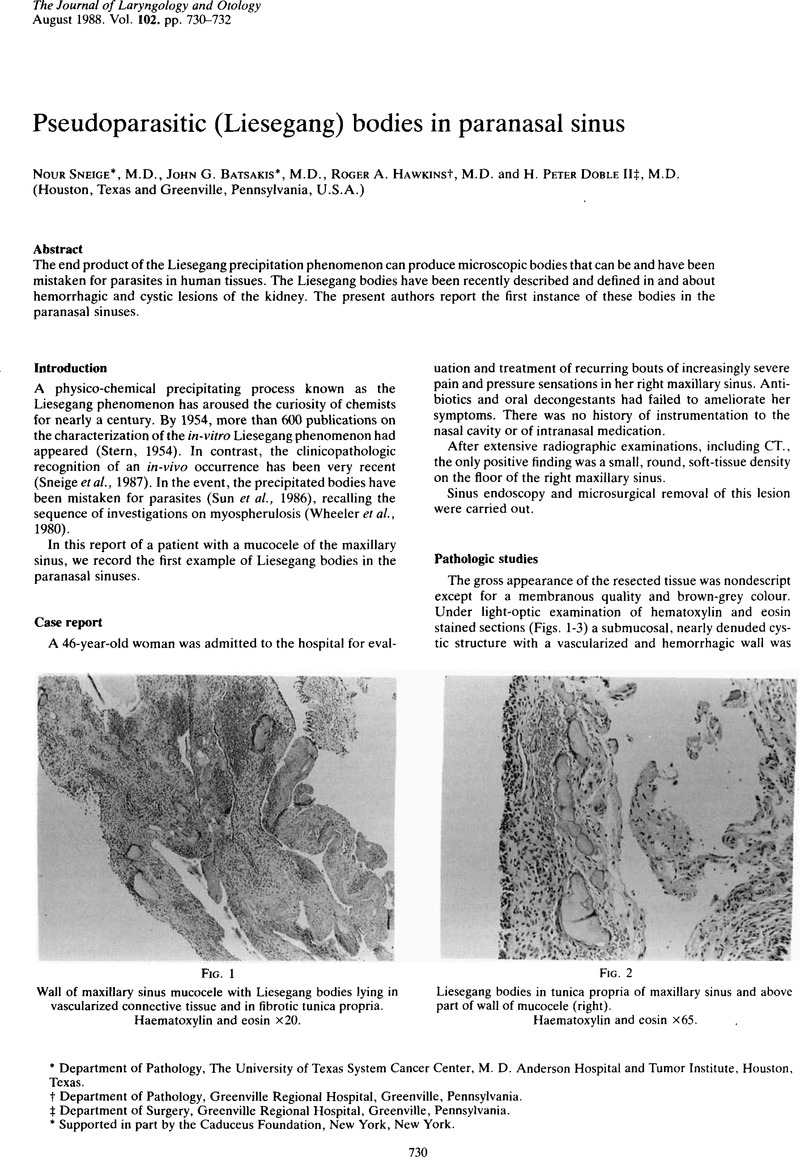Crossref Citations
This article has been cited by the following publications. This list is generated based on data provided by Crossref.
Padwell, A
1995.
Liesegang rings associated with a cystic lesion of the eyelid..
British Journal of Ophthalmology,
Vol. 79,
Issue. 7,
p.
706.
Polito, E
and
Leccisotti, A
1995.
Orbital varix in Gronblad-Strandberg syndrome..
British Journal of Ophthalmology,
Vol. 79,
Issue. 7,
p.
707.
Raso, Dominic S.
Greene, William B.
Finley, James L.
and
Silverman, Jan F.
1998.
Morphology and pathogenesis of Liesegang rings in cyst aspirates: Report of two cases with ancillary studies.
Diagnostic Cytopathology,
Vol. 19,
Issue. 2,
p.
116.
Pavot, Dawn R.
Atkins, Kristen A.
and
Powers, Celeste N.
2001.
Liesegang rings in a submental mass: Fine‐needle aspiration with histologic correlation.
Diagnostic Cytopathology,
Vol. 25,
Issue. 5,
p.
331.
Sis, B.
Canda, T.
and
Harmancıogˇlu, Ö.
2003.
Liesegang rings in a fine needle aspirate from a breast cyst.
Cytopathology,
Vol. 14,
Issue. 4,
p.
223.
Ilie, Marius
Hofman, Véronique
Butori, Catherine
Lassalle, Sandra
and
Hofman, Paul
2009.
Caractéristiques morphologiques et principales étiologies des infections rhino-sinusiennes.
Annales de Pathologie,
Vol. 29,
Issue. 4,
p.
313.
Onodera, Manabu
Sato, Yasunori
Ikeda, Hiroko
Zen, Yoh
Sakai, Seisyo
Syoji, Masao
Sakamoto, Koya
Tani, Takashi
Asaka, Masahiro
and
Nakanuma, Yasuni
2009.
Biliary deposition of Liesegang rings presenting as a polypoid mass in the liver: Previously unrecognized lesion.
Pathology International,
Vol. 59,
Issue. 8,
p.
577.
Pegas, Karla Laís
Edelweiss, Maria Isabel
Cambruzzi, Eduardo
and
Zettler, Cláudio Galleano
2010.
Liesegang Rings in Xanthogranulomatous Pyelonephritis: A Case Report.
Pathology Research International,
Vol. 2010,
Issue. ,
p.
1.
Islam, Mohd T.
Ou, Joyce J.
Hansen, Katrine
Simon, Rochelle A.
and
Quddus, M. Ruhul
2012.
Liesegang-Like Rings in Lactational Changes in the Breast.
Case Reports in Pathology,
Vol. 2012,
Issue. ,
p.
1.
Sancheti, Sankalp
and
Jain, Shivani
2018.
Liesegang Rings: Extremely Rare Structures in Malignant Lesions.
International Journal of Surgical Pathology,
Vol. 26,
Issue. 1,
p.
39.
El Hussein, Siba
Guerrero, Dominick
and
Khader, Samer N.
2019.
Peritoneal involvement by salpingoliths clinical significance and cytological challenges of interpretation.
Diagnostic Cytopathology,
Vol. 47,
Issue. 12,
p.
1302.
Shetageri, Shruthi Neelakanth
Parthiban, S R Raja
Karthik, L R
and
Hamza, A Mohamed
2019.
A Rare Incidental Finding of Liesegang Rings in a Case of Clear Cell Renal Cell Carcinoma.
Journal of Medical Sciences and Health,
Vol. 04,
Issue. 03,
p.
29.
Almotairi, Wejdan
Alhamam, Abdullah
Alotaibi, Aali
El Sharkawy, Tarek
Alsaif, Hind S.
Almousa, Abdulatif
Alsowayan, Ossamah
Eldarawany, Hamed
Fadaak, Kamel
and
Bergmann, Lothar
2021.
A Rare Presentation of Lisegang Rings in Adrenal Cavernous Hemangioma : Case Report and Literature Review.
Case Reports in Medicine,
Vol. 2021,
Issue. ,
p.
1.
Gross, Alexander R
Amin, Shahrier
and
Jelic, Tomislav
2022.
Liesegang rings in the setting of end‐stage renal disease.
IJU Case Reports,
Vol. 5,
Issue. 6,
p.
423.



